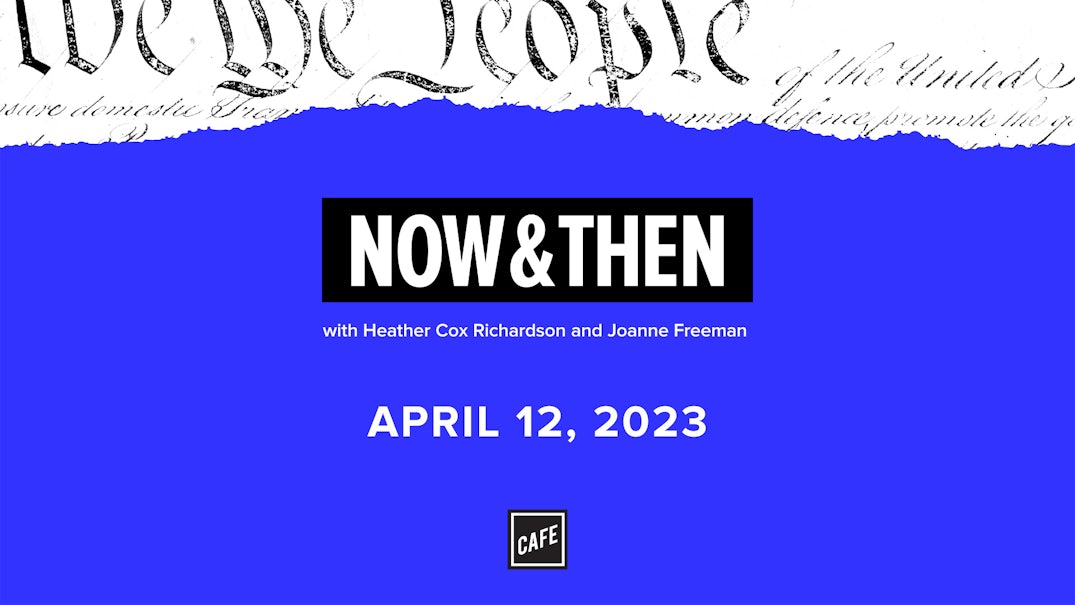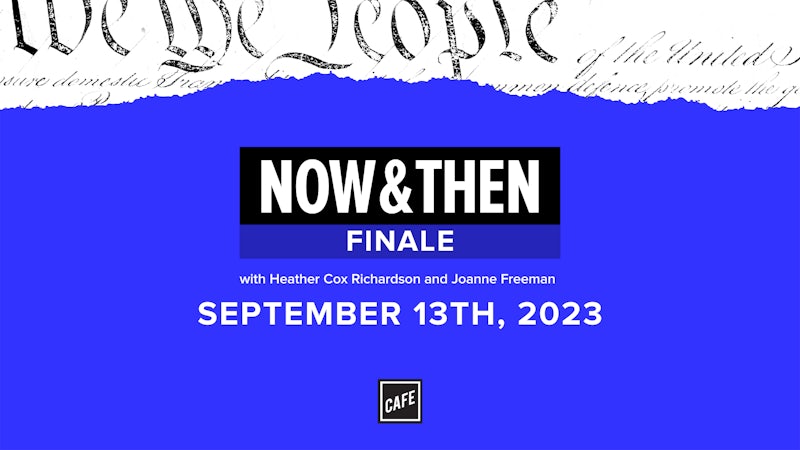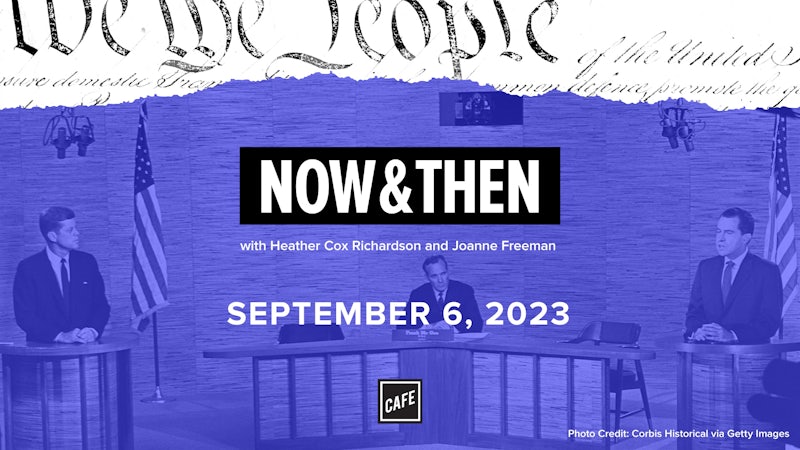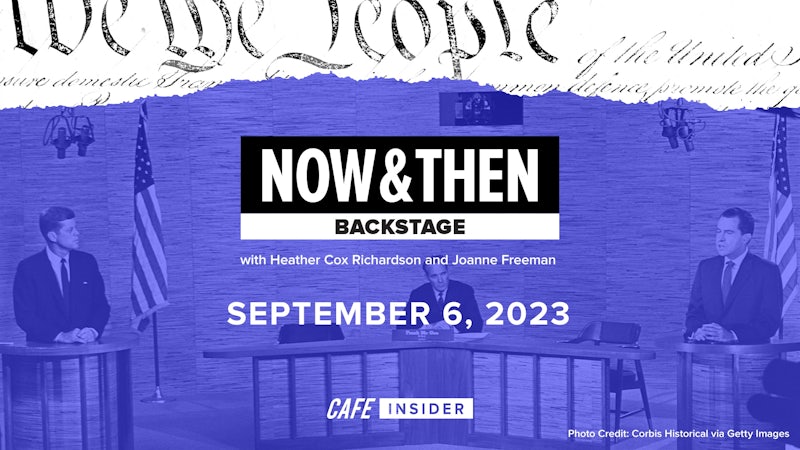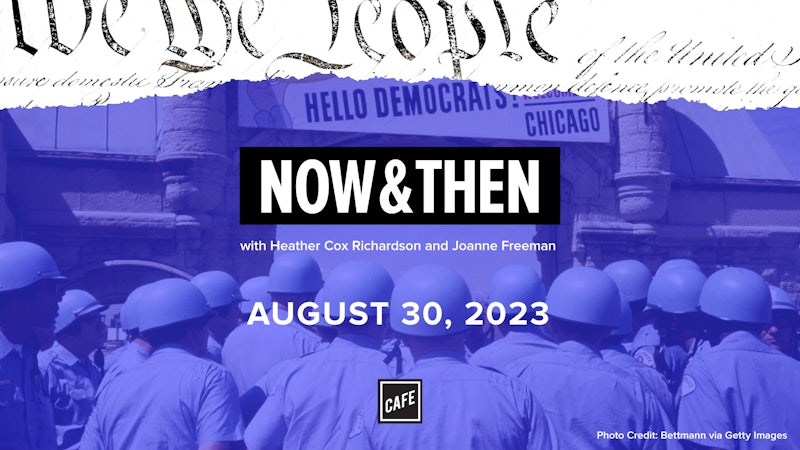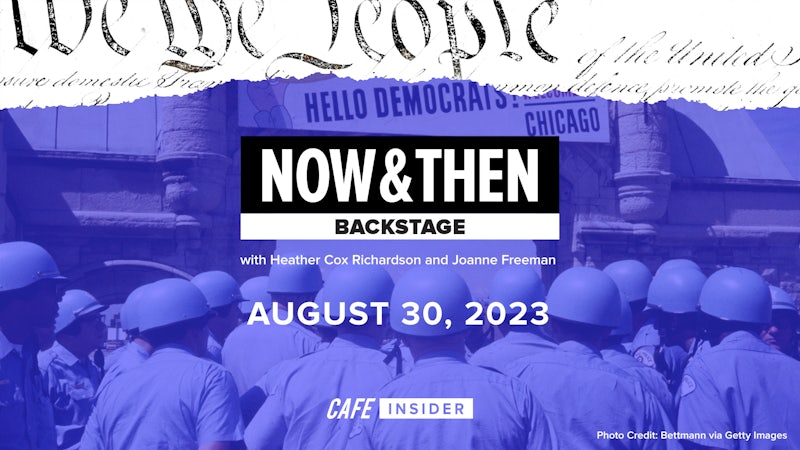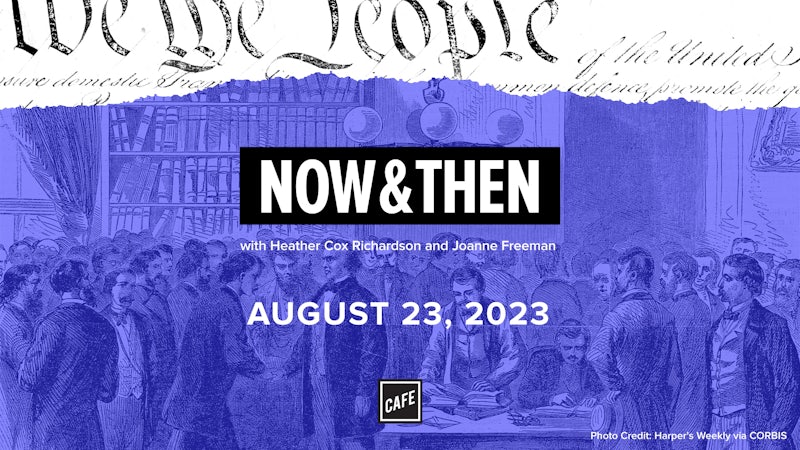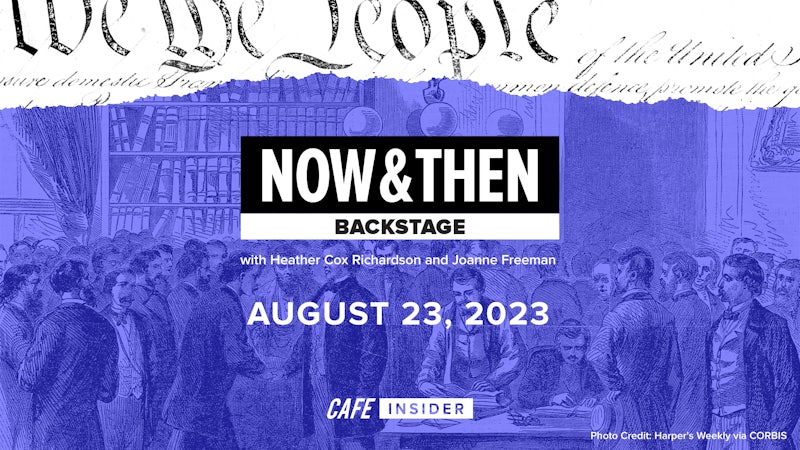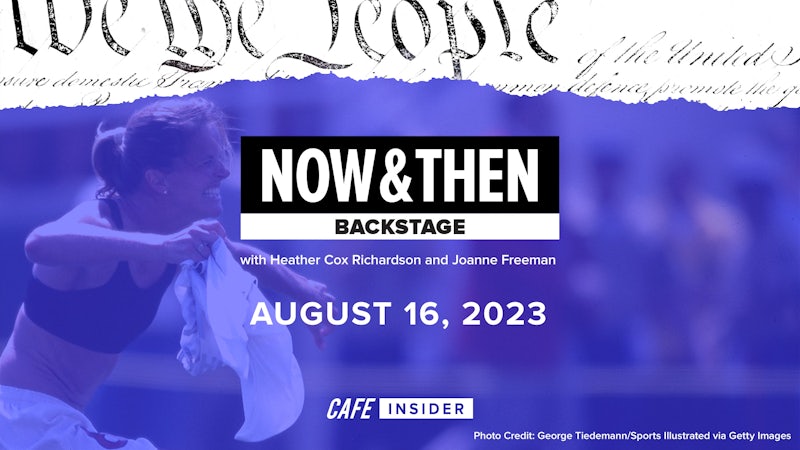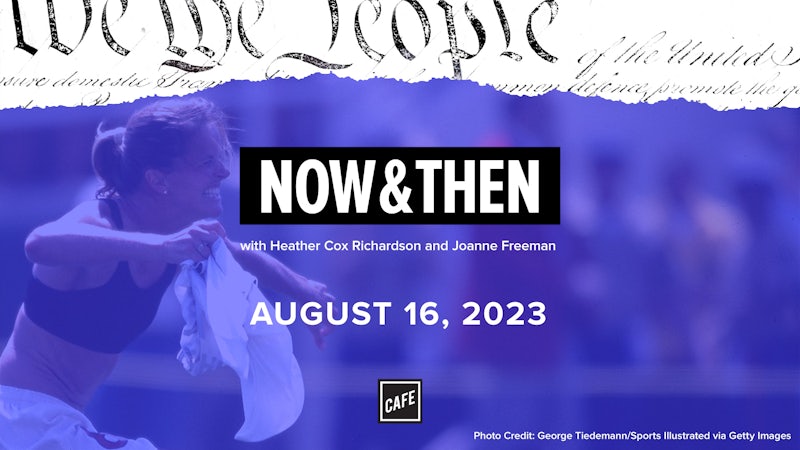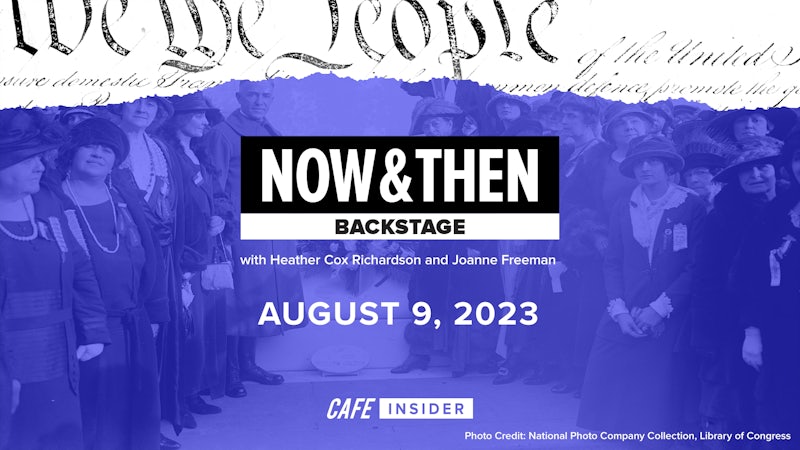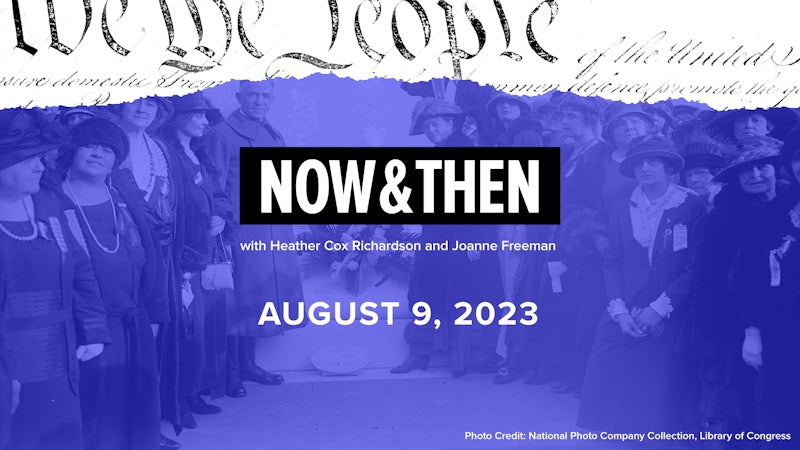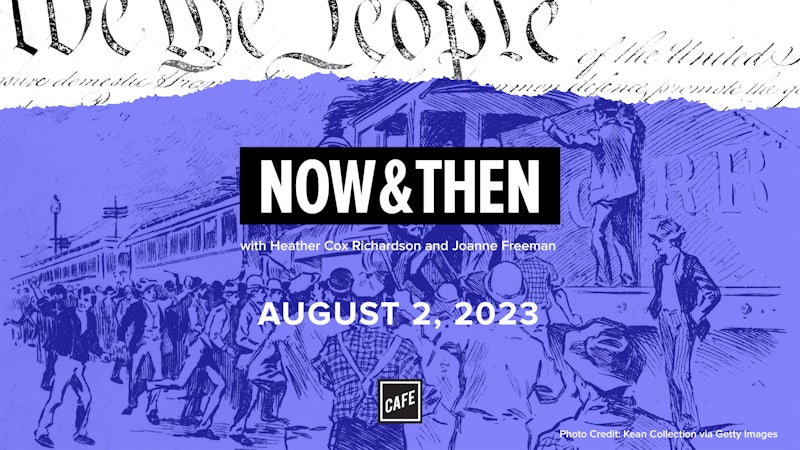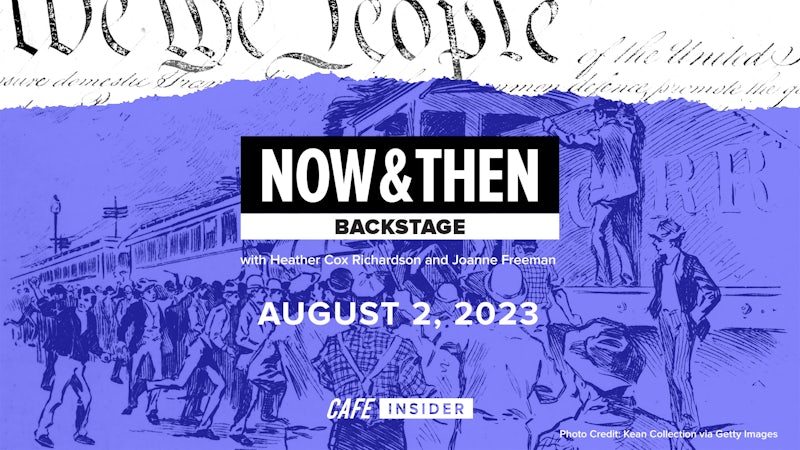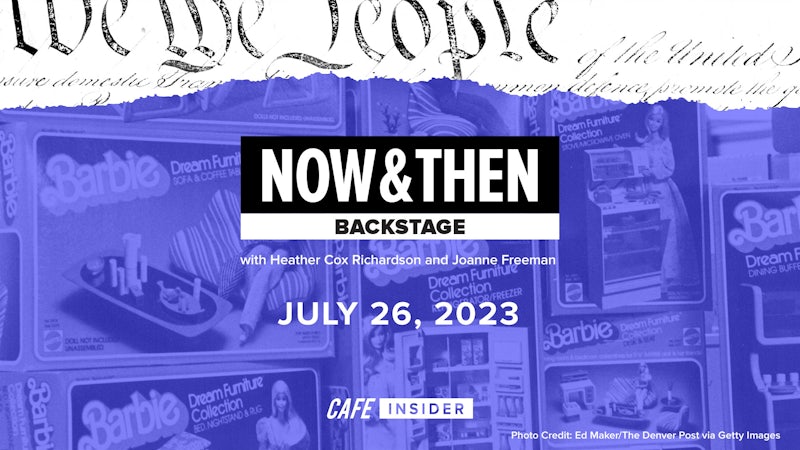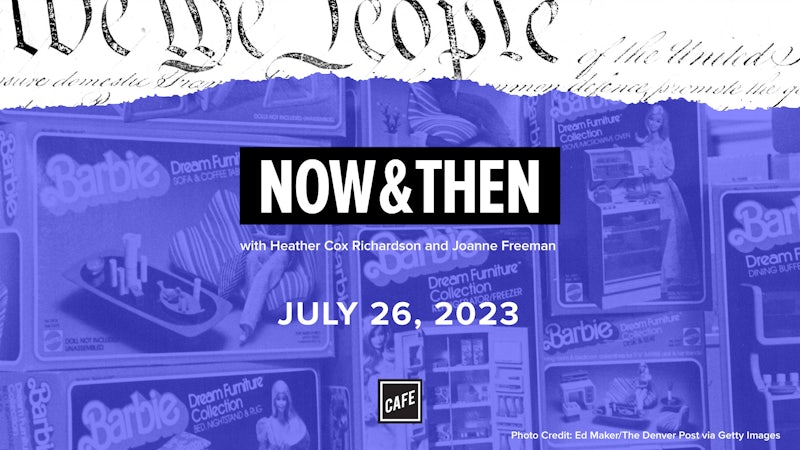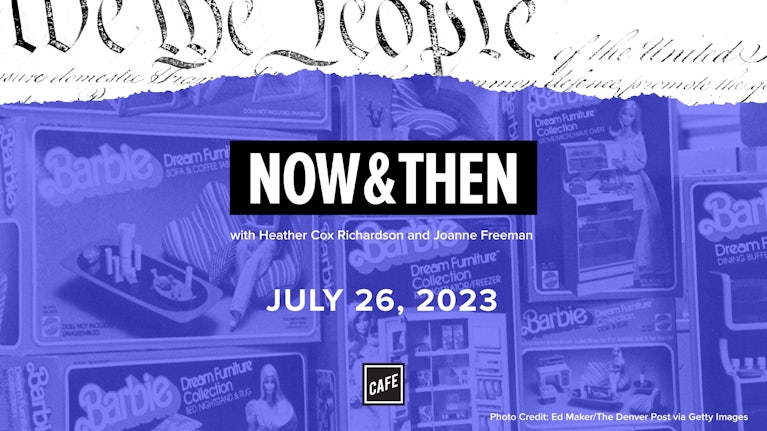Heather Cox Richardson:
From Cafe and the Vox Media Podcast Network, this is Now & Then. I’m Heather Cox Richardson.
Joanne Freeman:
And I’m Joanne Freeman. Today we’re going to be talking about a grave, but important and extremely timely topic, and that is high profile hostages throughout American history. Now obviously this topic is in part a reaction to the fact that Wall Street Journal reporter Evan Gershkovich, widely respected reporter, 31 years old, who covers Russia, Ukraine, and the former Soviet Union, he has been captured and I guess formally charged now with espionage. Of course, he was stationed as a correspondent there in Russia, but now this very serious charge has been brought against him and a charge of espionage carries a prison term of up to 20 years.
And it’s noteworthy that according to the New York Times, the last time an espionage charge was brought against an American reporter was 1986, which was towards the end of the Cold War, a period again where there’s a geopolitical ideological battle going on with the United States on one side and the Soviet Union on the other. But in the case of the person charged with espionage in 1986, Nicholas Daniloff, he was returned home a few weeks later in a prisoner swap. It’s noteworthy that what we’re seeing now in some ways echoes what we are seeing at another time of extreme differences, to say the least between the United States and Russia.
Heather Cox Richardson:
Last week, Secretary of State, Antony Blinken said that there was no doubt that Gershkovich was wrongly detained, but of course, the United States is still in the midst of a formal process to reach a formal determination of that. He also has had a conversation with the Russian foreign minister, Sergey Viktorovich Lavrov, to call on Russia to release Gershkovich, and of course his fellow American prisoner, Paul Whalen, who’s been detained for a number of years now. Gershkovich is the American son of Soviet born Jewish exiles. He grew up in New Jersey. He graduated from Bowdoin College in Maine, which put out a statement very shortly after his detainment, and he had been a reporter in France and in Moscow before he took this current assignment in Russia. Now, there’s a couple of things I wanted to say about this. First of all, we are of course strongly pulling for Gershkovich’s family and for him hoping for his immediate and safe return.
But when this happened, we jumped on the idea of focusing on him in part because of the extraordinary danger that journalists are in. I mean, people tend to root on journalists a lot and complain about them, but of course they have a vital role to play in our understanding of the world and of our governments because they are in dangerous places and they are risking their lives for our safety. So this is not really just a story about some guy who was in Russia and got taken, this is a story about access to information and the way that governments respect the people who deliver that information to us. And it’s something that is extraordinarily dear to my heart when you think especially of the dangers that journalists are in.
Joanne Freeman:
By definition, if you think about it, journalists and photojournalist are directly trotting on the middle line in warring countries, states, factions between fighting sides. So by definition, they are just in the line of danger, being in the line of danger is their job. So part of what we wanted to talk about today relates to that too, which is the actual human experience of being a prisoner or a hostage and what that suggests more broadly about the people doing the hostage holding and the place where that hostage is from. In some ways, we’re going to be talking about several incidents that have a really interesting middle line between them that you’ll see these prisoners are walking carefully along.
Heather Cox Richardson:
So let’s start with the revolutionary period because for some reason some people like that one.
Joanne Freeman:
I wait every week, Heather. It’s like what will be the early American insult this week?
Heather Cox Richardson:
Actually, I’m teasing in part because to me this is the, what do they call it, the catbird seat, if I’m using that term correctly. I get emails all the time from people going, oh, tell me more about X. And I’m like, well, yeah, I actually know something about that. In this case, I’m the person who gets to ask the expert about a period I know very little about. So I assume we have here somebody who did something to get into trouble.
Joanne Freeman:
And then got in trouble indeed.
Heather Cox Richardson:
And I’m going to hope he gets out. Or is that a spoiler?
Joanne Freeman:
Oh, you’re giving away the plot line. No, he does. The person who Heather is referring to is General Charles Lee. He was actually the second in command in the continental army and he ends up during the Revolutionary War being taken prisoner. He’s captured in 1776 and he’s held prisoner until 1778 when he’s exchanged for a British prisoner on the side of the Americans. In and of himself, he’s an interesting quirky individual who like to be surrounded by his pack of dogs at all times and when he’s imprisoned, even asks if his dogs could be brought to him where he’s on parole so that he can be with them at all times. But what’s interesting is Lee is by birth English, meaning born in Cheshire, England, 1731, joins the British army at age 14 and serves at a variety of European armies and then comes to North America in the 1760s as a British officer in the French and Indian War and gets involved in the revolutionary cause.
Now you can see how he becomes an invaluable person in the continental army. He’s a British officer with European training and the American army is still in its youth. So the fact that this experienced person comes along, very often, soldiers from foreign countries would come to the revolution explicitly because they knew they could bank on their military experience abroad and then be made an officer and then raise their social status. So at any rate, Lee is one of these characters. So he starts out with the British, he gets swept up in one way or another with the revolutionary cause second in command with the continental army and then goes on to fight in a variety of capacities at a variety of battles for quite some time with the continental army. But in 1776 Washington commander-in-chief orders him to move his troops to join Washington’s troops, to have enough of a force to hold off the British. Washington is retreating from New York at that point.
Heather Cox Richardson:
Washington is in New Jersey?
Joanne Freeman:
New Jersey, he’s going to keep going to Pennsylvania. New York has now basically been captured by the British. Washington and the continental Army have retreated and they’re headed south. He’s in New Jersey and Lee had been further south and he wants Lee to join him in New Jersey so that together they can go to Philadelphia. And Lee doesn’t want to do this. Lee didn’t like Washington particularly, he didn’t think he was a very good general. There was a lot of talk in the army that someone should replace him and probably Charles Lee considered himself a candidate. So did Horatio Gates, and Lee and Gates talk about this all the time. So Lee doesn’t follow ultimately three or four increasingly urgent letters from Washington telling him, you must come. The first two times, it’s kind of like, I’m sorry, George, the first two times it’s like, this would be good to do, really this would be good to do.
And then it moves into the realm of you need to do this. And Lee’s explaining why he doesn’t think it would be a great idea. He thinks, wow, the civilians might rise up with us and I can do that here. He’s just resisting and in some way also showing a lack of respect. So in a sense, what Lee wanted was a guerilla war strategy where citizens would be joining up with the army and fighting. And that’s not surprising in a way because that’s one of the things that American revolutionaries were doing that were not traditional in a European war where people would march in formation, wasn’t always formation happening in the United States. So it makes sense that Lee would think that was a great idea. Embracing the guerilla aspect of it was not something that Washington was doing and it was something that caught the British by surprise at certain points, particularly early in the war. So Lee is unhappy.
Heather Cox Richardson:
And I bet Lee’s life is going to get a lot worse really quick.
Joanne Freeman:
It is, it is.
Heather Cox Richardson:
Okay.
Joanne Freeman:
His part of the army in camps, he goes to Widow White’s Tavern in Basking Ridge, New Jersey for the night. It’s unclear what he was doing there. There is murmuring that he was seeing a prostitute there, but if you judge by the fact that he had a guard with him, he had a servant with him, it seems more like he found a comfy place to encamp not on the field with his army, but regardless he’s captured there. Doesn’t take very much Lee later complains that his “rascally guard” didn’t behave very well and there’s not much of a fight. British officers noted that derisively. Captain Thomas Harris wrote about Lee Surrender in his journal and said, Lee behaved as cowardly in this transaction as he had dishonorably in every other after firing one or two shots from the house, he came out and then treated our troops to spare his life.
Now you have to also realize here that Lee started out with the British army. So the British aren’t going to be really thrilled with Lee as a figure. So at any rate, Lee is a prisoner. What’s interesting during that period is that it’s unclear what his status is and they debate this whether he’s a deserter from the British army, whether he’s actually a prisoner or something worse, and how he should be treated. Meanwhile, Lee is on parole waiting to see what happens and waiting to be exchanged for another officer of his rank. And that’s the interesting thing about prisoners in this period is that you exchanged equals, or maybe like five lower ranked people for one higher ranked people. Somehow they made all those kinds of arrangements in a way that made sense. Lee, while he’s in captivity, is very friendly with the British and it’s discovered later in his papers that he seemingly had been preparing a plan to give the British to inform them about what the continental army was doing.
The papers are discovered in the 1860s or the 1870s. The thing about Charles Lee that’s interesting is talking about treading that line, right? He’s formerly a British officer, now he’s an American officer. He’s captured by the British and not necessarily liked because he’s seemingly possibly a deserter and he empathizes with the American cause, but is very cozy with the British, gets to see a lot of his old friends when he’s on parole, talks with general how British General, how is helping make these plans about what might happen and how the British might win. So Lee is held a prisoner and ultimately is released and goes back to battle. But think about that space that he embodies there, the place where he is, and the fact that Americans are going to be outraged that their second in command is being held prisoner and the British are going to think in one way or another, they’ve captured someone extremely handy and he sits at that nexus.
Heather Cox Richardson:
I just want to throw one thing in here, worth explaining what parole actually means in this period.
Joanne Freeman:
Indeed, and I find this really fascinating, the idea of parole regarding prisoners in this period in the 18th century. Basically there was a general idea, and it is entirely class or rank based, is that if you were an officer and you were taken prisoner, you would generally be released on parole, meaning on your honor. So it would be like a house arrest in a sense. Like okay, you’re a prisoner and you’re on parole, which means you have to stay where you are. And most important of all, you can’t take up arms again against the enemy. You’re going to not go back to what you’re doing, you’re going to not fight against the enemy. And these are high ranking individuals who in some cases are just living it up wherever they happen to be paroled and having a life and waiting to be exchanged. This whole system among officers is grounded on this idea that people will do what is right. We are all gentlemen in one way or another the British and Americans would say at this point.
Heather Cox Richardson:
So this is what fascinates me about hostage taking is the degree to which these individuals, once they have become hostages, operate, you know what? In mythology we would consider a liminal space that is they’re different than everybody else and they have their own experience that is unique. Nobody is going to be where Charles Lee is. So people speculate about what they’re doing, why they’re doing it, and as they’re doing that they project onto that individual different stories that may or may not be true. We can never know what the reality is for somebody like that. Who was he really? What was he doing? And people project onto that.
Joanne Freeman:
Who is this person and how are we going to imagine that person? Who do we want or need that person to be? Because that’s part of what we’re talking about here is that there’s this person who is in a sense embodying a conflict by being a prisoner or a hostage and each side in their narrative is going to want or need that prisoner or hostage to represent something.
Heather Cox Richardson:
Yeah. Is Charles Lee a weenie who has gone back over to [inaudible 00:14:49].
Joanne Freeman:
I have never uttered that sentence either.
Heather Cox Richardson:
That’s why I’m here, Joanne.
Joanne Freeman:
Weenie has appeared more in my life, that word, since I have known you than ever, ever before. This is one of the gifts you’ve given me.
Heather Cox Richardson:
Well, it strips it down to it’s essentially and do we respect this man and his honor or is he just a turncoat? And that idea of we project onto this outside figure, our version of the truth is a really, really interesting one.
Joanne Freeman:
I love the idea of being liminal because for example, Lee who’s hanging out with some old friends from when he was a British officer and chatting with the British General, at one point, he writes, “I could not help whilst I was prisoner being astonished at the bad policy and stupidity of some of the British officers who made it their constant business to depreciate the character of the Americans in point of courage and sense.” So on the one hand, he’s there with the Brits engaging in a brotherhood with them. On the other hand, he’s saying, you idiots, you really think so little of the Americans, that’s not going to serve you well, plus it’s not true. So he himself is in a space where he’s looking towards both sides.
Heather Cox Richardson:
And this leads pretty naturally to the first person we both thought of when we talked about an episode about hostages. And that is Republican congressman from New York who in 1861 was captured by the Confederates after the battle of Bull Run. His name was Alfred Ely, and he symbolized for the north the idea that the Civil War was not going to be the cakewalk that they had imagined it was going to be. He becomes this very powerful symbol of how bad the war was going to be, how long it was going to go on because he was a congressman. He was a sitting congressman when he gets captured. So the story behind him is that he came from Hartford, Connecticut, born in 1815, he moved to Rochester, New York. He became a lawyer when Rochester was growing lots of milling interests. He married the daughter of a wealthy mill owner.
He ran for Congress in 1858. He was part of the attempt to stop the spread of the slave power into the American west. He spoke out against slavery. He’s a typical New England, what would they call the burned over district Congress critter in the years immediately before the Civil War. But then we get to the battle of Bull Run. And what happened there was that both the North and the South had this fantasy that the Civil War was only going to be a single battle that the other side would turn tail and run. And there’s a famous confederate politician who says he will personally drink all the blood that’s spilled in the Civil War. I mean, they really downplayed how bad things were going to be. So the president and his cabinet put a lot of pressure on Winfield Scott, who was the head of the army to go ahead and start this war.
And Scott, who understood just how hard this war was going to be actually had on paper said, no, no, no, this ain’t going to be quick. And he came up with a system that of strangling the South that was known as the Anaconda plan that looked pretty much the way that the United States finally crushed the Confederacy. But of course everyone’s like, oh, he’s just being ridiculous. Of course it’s not going to take that long. So he really gets forced into a battle pretty quickly and that’s the battle of Bull Run in July of 1861. But the Congress people think this is going to be just so wildly entertaining.
Joanne Freeman:
That’s the part of this that fascinates me is that many members of Congress and reporters and just average citizens, and this along the lines of what we’re saying, they’re so convinced of the superiority of their troops and their cause that they assume that it’s safe to travel out to the battlefield with little picnic baskets to watch a battle.
Heather Cox Richardson:
And their wives and their daughters, and they drive about 30 miles to the southwest of Washington out to the battlefield, and they settled down with their picnics to watch the battle of Bull Run. It doesn’t go very well.
Joanne Freeman:
No, it doesn’t go very well. And I have to say Ely wrote a journal while he was a prisoner of this entire episode, and he acknowledges with probably a little bit of embarrassment that he partly just was curious to see the army in the field. And so that’s part of why they went. And he describes how his carriage breaks down. He decides he’s going to walk a little bit part of the way. There’s someone coming with him, a servant or carriage person following along with him, and at some point this person stops and turns around and Ely says like, huh, I wonder what that’s all about. And of course later he says, because I’m walking onto a battlefield. The whole thing is fascinating because ultimately, he’s hiding behind a tree and actual ammunition is flying by him, and he realizes that this is a real war and he’s getting captured.
Heather Cox Richardson:
They’re all sitting there trying to watch this battle, and at first it looks like the union’s actually going to win and the battle turns very quickly and he gets separated from the people he’s with. He ends up, you say, hiding behind a tree and he ends up being overtaken by confederate troops and captured by a confederate officer. Now for their part, the Confederates also thought it was going to be a single battle and that it was going to be this gallant, maybe a few people will die in heroic ways, but basically we’re all going to have this battle. We’re going to win and it’s all going to be over. And actually, one of the things that always jumps out at me about this particular period, Joanne, is if you look at the cemeteries that have union dead in them, the graves from this first wave in the summer of ’61 tend to be incredibly elaborate.
Sometimes their entire carved soldiers, it’s clear that they think these are the martyrs to this cause and there’s only going to be a handful of them. And of course, by the end, there’s so many wounded and so many dead that the entire ways of understanding our dead change to make it’s overtaken by a confederate officer who starts by saying everything’s good. Ely says in his journal, the officer repeatedly assured me that I should not be harmed and behaved with kindness and courtesy. He took me to the colonel sitting on horseback and introduced me in these words, Colonel, this is Mr. Ely, representative in Congress from New York. But then the game changes as Ely recalls it, to which the colonel in a most angry tone replied drawing his pistol and pointing it directly at my head, God damn, your white livered soul, I’ll blow your brains out on the spot.
Joanne Freeman:
I have to pause at this point only because he goes on to say in that journal that a confederate officer jumps in at this point and pushes away this colonel who is pointing the gun in his head and says, no, no, he’s a prisoner, you can’t do this. And what’s fascinating about Ely’s experience of being a Confederate prisoner, it’s like what we were just saying with Charles Lee. He writes a lot about how former colleagues of his in Congress who are now in what he called the rebel Congress, they come to visit him. They want to make sure he’s being taken care of correctly. He’s chatting with them, they’re sympathetic. They give him a different understanding in some ways of what the Confederates are about. He doesn’t change his sense that they’ve succeeded from the union and need to be fought in a war.
But like Lee, he’s in this place where on the American side, he’s a congressman who’s being imprisoned, he is being held hostage, and on the confederate side, well, he’s one of us, so he’s a gentleman, he needs to be treated decently. Again, the experience of this captures the fluidity and the amorphous nature of these kinds of conflicts, particularly between people who once were one people in hour two, British and Americans Union and Confederate.
Heather Cox Richardson:
Well, and for the Northerners, especially those in Congress, they look at his empty seat and he doesn’t have a long-standing history in Congress, so it’s not like they’ve taken Charles Sumner or something, but they keep looking at that empty seat and the fact that one of them is a prisoner of war is mind-blowing to them and makes them realize just how real this war really is, because of course, there’s not going to be another really major battle until the following year simply because both armies are so completely non-plused at what happened at Bull Run, but that sense that he is of them and captured, what does that actually mean?
Joanne Freeman:
On both sides though of them are captured, right? The Confederate former members of Congress are saying that and the now members of Congress are saying that it shows you particularly at that early point in the war, how thin that dividing line in some ways was in reality on the ground.
Heather Cox Richardson:
Yes, he’s quite apprised to have taken as well. So he ends up going to Libby Prison, which was converted tobacco warehouse in Richmond, Virginia. There were 594 union prisoners of war there, and he does manage to get a letter out speaking of having connections to a newspaper man in Rochester saying, yeah, I’m alive and I’m imprisoned, and here are the names of some of the other POWs with me. Then later on he gets transferred to another tobacco warehouse called Castle Funder, and because of his status, he receives decent treatment during his captivity compared to the average union prisoner of war at the time. A month into his captivity, he does write to his wife Caroline about the fact he’s concerned for the imprisoned troops because they have to deal with rats and insects and buckets for toilets. Now, this is before we’re going to get to the true prisoner of war camps that people associate with the Confederacy like Andersonville. There are still prisoner exchanges going on, so the conditions in the prisons are not going to be as horrific as they are going to be by 1864.
Joanne Freeman:
There simply aren’t as many people to deal with as the war continues. There’s so many people to deal with that things disintegrate in part, I think he serves six months and he’s released. There’s a trade for him. But what’s interesting about him is he publishes his prison journal and he periodically would testify before legislators about his experience and his advocacy for other prisoners of war. For example, in February 1864, he condemned the Confederate prison system. He’s fascinating in part because he is again in this middle ground, this liminal space. Both sides in some sense have a sense of ownership. He comes away from this more focused than anything else on the experience of being a prisoner, what that means and how that should work in future.
Heather Cox Richardson:
I mean, he is one of the situations that I find really interesting because his is the name many people today have not heard. He was not a mover and shaker in Congress. He’s really known to historians primarily because he was taken captive of the battle of Bull Run, but he’s huge at the time. Everybody knows this guy’s name because he’s a congressman who has been taken prisoner.
Joanne Freeman:
That’s the way he’s always referred to when he’s a prisoner. This is a member of Congress. Now this isn’t like all of our other prisoners.
Heather Cox Richardson:
So he becomes a symbol in a way that is far greater than the rest of his public presence. He has an out-sized significance because of his space in between these two warring sides. For people who study the Civil War, he’s a really big deal. He comes up all the time, and yet not because of who he was, but because of who everybody else was.
Joanne Freeman:
But that’s the ultimate proof of this symbolic importance of these kinds of characters, right? To us, we don’t really remember him or see him. It’s not as though at the time he was this hugely important member of Congress. He becomes known and significant and he becomes a symbol when he’s captured.
Heather Cox Richardson:
Which brings us very naturally to the hostage that must have been on everybody’s minds when we said we were doing an episode about hostages.
Joanne Freeman:
Indeed, Patty Hearst.
Heather Cox Richardson:
So some quick biographical details. Patty Hearst was a San Francisco heiress. She was captured by the Symbionese Liberation Army in 1974. She became an active member of the violent group, and ever since there has been a debate over whether or not her participation was willful or forced, and I deliberately did that as factually as I possibly could because she is really the poster child for people not understanding what she went through because she’s unique, none of us can understand what she went through, but making determinations based on their reading of this cipher.
Joanne Freeman:
Once again, she becomes sort of a symbol of what she needs to be for each side to feel that they’re getting what they need from her. Again, she’s a 19-year old at Berkeley in February of 1974. She is the granddaughter of the publishing magnate William Randolph Hearst. So that family is certainly notable. Her father, Randolph Apperson Hearst was the managing editor of the San Francisco Examiner. It’s like a dynasty here, so it makes sense for her to be a target, but she’s a 19-year-old college student in her apartment. So she’s being taken partly for symbolic reasons and also for just crass attention reasons. That’s this kind of person is captured. It’s going to seize headlines, and the Symbionese Liberation Army in 1974 is certainly trying to make a name for itself.
Heather Cox Richardson:
They’re also known as the SLA, by the way. They believed in direct violent action against the wealthy and the redistribution of wealth to people in the Bay Area. So they break into her apartment, they blindfold her, bind her, and throw her into the trunk of a getaway car, and she has kept in a closet in the group’s hideout in a San Francisco suburb for the next two months. Now, the SLA was led by a man named Donald DeFreeze. He was a Black militant who had escaped from prison, from Soledad Prison in early 1973. He was serving at the time a six to 14 year sentence for bank robbery, and in the summer of 1973, they begin robbing banks in California. Once he gets out of prison, DeFreeze begins to bring into his group disaffected Vietnam veterans, radical activists. Many of his co-conspirators were college educated members of the group take on new revolutionary names that are usually honoring militants from past movements.
That’s going to matter in just a second. So then in the fall of 1973, the SLA decides that it doesn’t like a man named Marcus Foster, who is the Black superintendent of schools in Oakland, California, after local news outlets incorrectly said that he had expressed support for a plan to require students to carry identification cards in part of a plan to reduce drug use in school vagrancy. In fact, he had never supported the plan. Nonetheless, the SLA said that the act was fascist and decided to ambush him. That always jumps out at me too, by the way, the idea that students carrying IDs was fascist, right? When you think about where we are now anyway, right? So the SLA, assassinates Foster on November 6th, 1973 using bullets packed with cyanide, and they claimed responsibility six days later. They said the elimination of Marcus Foster was an operation to demonstrate our resolve to do the only thing we can, and that is to fight the capitalist ruling class.
Joanne Freeman:
So, at this point, the SLA already is known for the foster murder, but Hearst’s kidnapping three months later really does probably what the group wanted, which is bring it national notoriety. Eight days after her kidnapping on February 12th, 1974, the SLA released their first tape of Hearst. I have a vague memory of that as a matter of fact, and she expressed some initial sympathy for the group, but still pleaded with her parents to get her home. She said, mom, dad, I’m okay and with a combat unit that’s armed with automatic weapons, and these people aren’t just a bunch of nuts, they’ve been really honest with me, but they’re perfectly willing to die for what they’re doing, and I want to get out of here, but the only way I’m going to is if we do it their way, and I just hope that you’ll do what they say, dad, and just do it quickly.
Now, the SLA demanded from the Hearst’s a two million dollar food redistribution campaign as part of their ransom, and the Hearst family obliged and opened the People in Need program in Berkeley, although it didn’t operate very well for very long, and the SLA demanded an additional four million dollars in funds after that which Hearst couldn’t deliver. Hearst says the size of the latest demand of the Symbionese Liberation Army is far beyond my financial capacity, therefore the matter is now out of my hands.
Heather Cox Richardson:
Okay, just stop there for a minute. This is a man who is part of one of the wealthiest families in the United States, and the idea of a four million dollar ask is out of reach. There’s so many aspects of this story that seem frozen in the 1970s, and one of them is that you think about today’s richest Americans, four million dollars is like when you’re talking that there are certain people with billions with a B, I just find that particular moment fascinating. There is also the fact that in 1973 there is this big sense of after Nixon has polarized the country before the 1972 election talking about us versus them, and they want things and they are going to come for your tax dollars and they are going to overthrow society.
There is this sense that literally this group of militants has kidnapped the teenage daughter of one of the nation’s most prominent citizens. So she is the hinge in between a very different struggle than we saw in the revolution or in the Civil War, but very much between two factions that at least at the moment appear to be at war.
Joanne Freeman:
I also want to highlight the fact that if you think about various things that you might see in the news today, when there are parents pleading for children who are lost or captured, I don’t know if I’ve ever seen someone say, well, this is out of my hands. He’s signaling something to the press like, okay, I was willing to do some, but I’m not willing to do all. He’s taking a stand, but it’s a stand that his daughter is still a hostage and the SLA is still releasing these audio tapes of her pleading for help.
Heather Cox Richardson:
Ms. Hearst’s mother Catherine, began to dress in black signaling seemingly that she did not have hopes for her daughter’s safe return, and I just love this because, because Patty Hearst does another tape, and it just seems so human that those of us who have occasionally struggle with family members, mothers saying, I didn’t go there. I am an example and a warning she said, and because of this, it’s very important to the SLA that I return safely, and so people should stop acting like I’m dead. Mom should get out of her black that doesn’t help at all, and I am absolutely not poking fun at that situation itself. But can you just imagine being in this situation and having to try and manage your family members too, right? I was going to say, really? Come on.
Joanne Freeman:
A totally logical thing for her to be worried about and thinking. So what she’s saying makes perfect sense, but on a human level it’s also a daughter talking to her mother, and that comes across.
Heather Cox Richardson:
It’s such a human moment because when I hear that not mom should get out of a black dress or the black dress, she says, mom should get out of her black dress. And to me, I feel like you can see the two of them sitting in front of her closet with her going, not the black dress mom, try the pink one as if they’re getting ready for something the way my daughter does with me. It feels like such an incredibly human moment, and there’s so few human moments once somebody has entered this weird space in which they have this unique experience in between two warring factions.
Joanne Freeman:
Now, on April 3rd, almost two months after her kidnapping, the SLA turned over pretty much the most infamous of their tapes from Hearst, and in this tape, she reveals that she had been given the option to leave and had decided to stay and fight the system, and at this point, she reveals along the lines of what Heather said earlier, that she had taken the new name Tanya after Vivian Communist and Che Guevara ally, Tamara Tanya Bunk. Let me offer you her words before saying what really strikes me about it. I have been given the choice of one being released in a safe area or two, joining the forces of the Symbionese liberation army and fighting for my freedom and the freedom of all oppressed people. I have chosen to stay and fight. I have been given the name Tanya after a comrade who fought alongside Che in Bolivia.
What fascinates me about this point is that we started out with an attack on the wealthy, and that was the main divide here. Suddenly, this is generational too. Suddenly she and these younger people are joining up to fight the system, which in many ways is an echo of that moment in time. It gets back to some of what we’re talking about in this episode, which is the many ways, in many identities on both sides and how these figures are negotiating their way between them. Part of it is people attacking the system, the wealthy people, people who have power, but she’s also part of this revolutionary force fighting the system in a sense, as a young person in that period would voice it. It’s very much in tune with the times.
Heather Cox Richardson:
Once somebody has had a unique experience like this, and as far as I’m concerned, it’s absolutely hands off because who knows. But that being said, instantly people start to read onto her their version of where they stand in this seeming generational divide and class divide that seems to be characterizing the middle of the 1970s. So when in fact, two weeks after that communique on April 15th, she, along with members of the SLA, robbed a branch of the Hibernia National Bank in the Sunset District of San Francisco, security cameras capture images of Hearst armed with a sought off semi-automatic weapon and yelling at the bank goers during the heist.
Joanne Freeman:
It’s a really famous image. If you haven’t seen it, Google it and find it because I’m sure it will come back into your mind of her with the gun looking ferocious.
Heather Cox Richardson:
And immediately certain leaders in the United States react to her in a really different way. Again, this woman has been held hostage and we know all the things that are associated with that in terms of people’s psychological states, but immediately, for example, the US Attorney General William Saxby referred to her as a common criminal and said she was acting out of her own free will. So there’s partly there I think this sense that, oh my God, this could happen to any of our kids unless we stop these radicals. Our own children could end up in a bank with a sought off shotgun, but there’s also this instant that’s them. We’re going to fit her into this political pattern.
Joanne Freeman:
She has picked a side.
Heather Cox Richardson:
Yes, yes, and we are going to reflect off of that and pick our side. It’s that I think a profoundly sad moment.
Joanne Freeman:
And strikingly, I don’t want to say harsh, but it’s such a division, right? It’s not even we’re mourning for the fact that or she seems to have, certainly there was some of that, but generally speaking, the idea that she’s now being referred to as a criminal or you could feel the wall come down between them, the barrier that she’s now on a side with that kind of firmness, it’s striking. Because throughout this episode we’re talking about these people negotiating between sides. That’s what we’ve seen of her so far, and here, according to some people, she’s crossed such a line that they desperately need her to, in a sense, play a certain role, be a certain person to enable the so-called system or the United States to express what it considers to be authority and propriety and the rule of law.
Heather Cox Richardson:
And the proper role of a young woman in society.
Joanne Freeman:
Very true.
Heather Cox Richardson:
I think part of the horror was that this woman would pick up a sought off shotgun under any circumstances. The saga continues by early May. The SLA was in Southern California, and on May 16th, 1974, she fired 27 bullets into the front windows of Mel’s Sporting Goods in a neighborhood of Los Angeles after one of the members of the SLA got into a fight with the store’s manager, nobody got injured, but it did let the LA Police Department know that Hearst and the SLA were in the city. The next day, the LAPD tracked DeFreeze and five other SLA members to an apartment in Compton. There was a volley of gunfire between a police SWAT team in the S L A. Eventually, the police set the apartment on fire with gas canisters and DeFreeze and five of the SLA members were killed in the fire. After that, the SLA couldn’t really find direction. Eventually, it folded into the New World Liberation Front or the NWLF, and it supported the group’s bombing of a San Francisco stockbrokerage in the fall of 1974.
Joanne Freeman:
Now, by this point, Hearst is on the other side of the country. In June of 1974, a radical sports activist, so we’re really getting into all kinds of dividing lines here, and again, some of them are generational. His name was Jack Scott. He was known for a 1971 tracked decrying the corporate exploitation of athletes, and he orchestrated a hideout in rural Pennsylvania for Hearst and other surviving SLA members, even driving the group from California. Finally, in September of 1975, police arrested Hearst and three other SLA members back in San Francisco. Hearst defined her profession as urban gorilla while she was being booked. In 1976, Hearst had a front page trial, and she was represented by famed defense attorney Ley Bailey, who argued that Hearst was in danger and acting for her self-preservation throughout her entire captivity, and this is a bit of Bailey’s closing during that trial. She said, this is not a case about a bank robbery.
The crime could have been any one of a number. It’s a case about dying or surviving. That is all Patricia Campbell Hearst thought about, and the question is, what is the right to live? How far can you go to survive? We all know that it is a human impulse, a generic, irresistible human impulse to survive. People eat each other in the Andes to survive. The big question is, and we don’t have it in this case, thank God, can you kill to survive? Now, to me, what’s fascinating about that is that Bailey, with that argument takes away sides. Nope, we’re not talking about sides, we’re talking about humanity. We’re talking about being a person, and that’s all this is about. So it’s a brilliant strategy. It’s just trying to totally repaint the framing of what happened and how people understood it.
Heather Cox Richardson:
And to recognize her as that individual who got lost as people read their stories onto her. The jury rejected those claims and they found her guilty of armed robbery and sentenced her to seven years in prison. But that too is going to become political football, if you will. By 1978, though the number of radical bombings had decreased, a number of Democratic congressional voices began to speak up for Hearst and argued that President Jimmy Carter should commute her sentence. President Carter’s Attorney General Griffin Bell recognized that this was really a politically sensitive issue. In 1978 on the MacNeil/Lehrer NewsHour, he said:
Griffin Bell (archival):
You would most likely if she got released, it’d be to commute her sentence to time saved. Now, if she got that kind of treatment, people would say, well, she got that because she was rich. On the other hand, if she’d been on some unknown non-script person, maybe she wouldn’t have got as long sentence. Anyway, the thing I would like to see, I’d like to see a comparison between how she was treated as against her kidnappers, the Harrises. I’d like to see a comparison to that, the kidnapped and the kidnappers.
Heather Cox Richardson:
On February 1st, 1979, president Jimmy Carter did commute her sentence after she had served 22 months, and she went on to have a career as an actress and a producer and a philanthropist. Finally, president Bill Clinton formally pardoned her on his final day in office, but we’d like to give her the last word here.
Joanne Freeman:
Absolutely, and in part because it brings us back to a point where we started and highlights that the idea that we’ve been framing throughout the episode about these figures, these hostages and prisoners being symbolic characters and walking a dividing line between warring people, that there’s a human struggle beneath that matters. And so here we have Patty Hearst on Larry King Live, January 22nd, 2002, and she says:
Larry King (archival):
Stockholm syndrome, part of the thinking or not, did you?
Patty Hearst (archival):
I’m sure it was. Of course it was. I mean, they call it Stockholm Syndrome and post-traumatic stress disorder, and I had no free will. I had virtually no free will until I was separated from them for about two weeks, and then it suddenly slowly began to dawn that they just weren’t there anymore. I could actually think my own thoughts. It was considered wrong for me to think about my family.
Joanne Freeman:
So there she’s attesting to where we started, which is this idea that you can’t really know the experience of people in this situation held in a symbolic position on two sides being invested with significance in various national narratives representing all kinds of things, and meanwhile, it’s also worth remembering sometimes some of these people and others imprisoned are being held hostage, they don’t necessarily even know all of this swimming around them. So here we end talking about the Hearst kidnapping with her because in essence she says, well, here’s what I think, and we don’t absolutely know, was it Stockholm syndrome, wasn’t it? She says they call it that, but I don’t think I had free will. The human experience and the symbolism of hostages and people take prisoner, it’s important to remember both sides because the symbolism is why they become, in a sense, national news.
They come to prominence that might even help them get rescued in one way or another because they come to national prominence on both sides. But underlying that is the human dynamic, which I think sometimes it can be easy to forget the human experience of undergoing this, and I don’t think people have necessarily, in the case of Evan Gershkovich, I don’t think people have forgotten the human experience of it, but he is also a highly symbolic character right now about Putin and what the Russians are thinking about the West versus America and journalism, and in one way or another, liberal democracy and freedom of the press. You can see how even right now, when we’re in the middle of one of these moments, how easy it is to lose track of the actual reality of what’s happening, and the fact that the symbolism as meaningful as it is not the whole story.
Heather Cox Richardson:
At the end of the day, it seems worth emphasizing that the fight over Evan Gershkovich, who is a hostage now between the United States and Vladimir Putin’s Russia is at the end of the day a story about him and we wish him and his family the very best.












